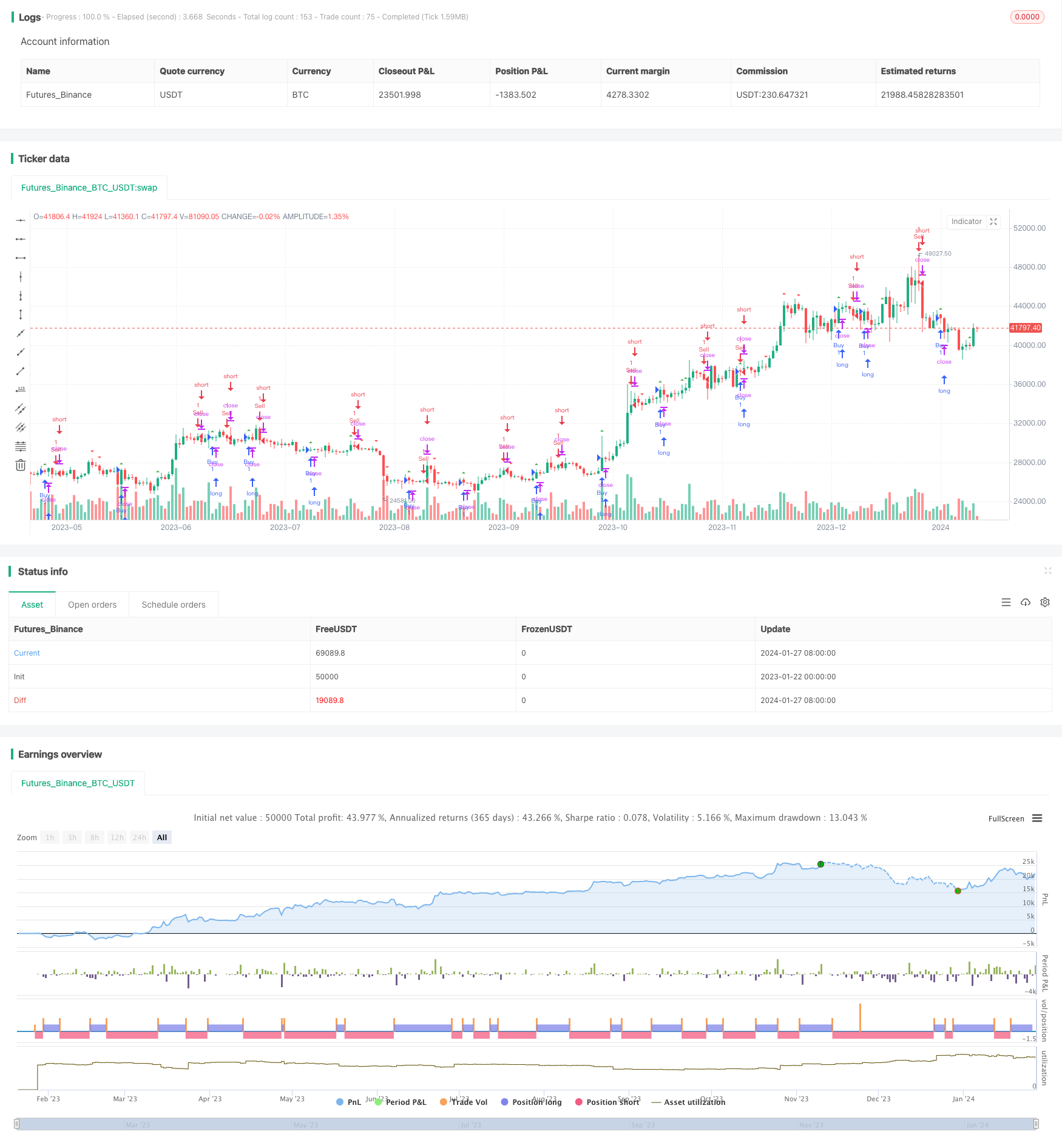
概述
该策略综合运用了Stochastic RSI和MFI两个指标来识别超买超卖现象,做出买入和卖出决策。其基本思路是在股票价格超买时考虑卖出;当股票价格超卖时考虑买入。
策略原理
Stochastic RSI指标结合了随机指标(KDJ)和相对强弱指数(RSI)的优点。它先通过RSI计算出一段时间内的RSI数值,然后应用随机指标的方法来计算这个RSI数组的stochastics K和D值,从而判断RSI是否超买超卖。
Money Flow Index(MFI)指标则基于成交量和价格的变化判断市场供需关系和超买超卖情况。该指标认为,价格上涨是多头力量强于空头力量的体现,当波动加大时,多头力量强于空头力量,因此成交额上升预示着多头推动价格上涨。
本策略设置了Stochastic RSI的超买线和超卖线,以及MFI的超买线和超卖线。当Stochastic RSI指标的K线从下向上穿过超卖线或MFI指标从下向上穿过超卖线时产生买入信号;当Stochastic RSI指标的K线从上向下穿过超买线或MFI指标从上向下穿过超买线时产生卖出信号。
策略优势
这种结合Stochastic RSI和MFI指标的策略,可以更可靠地识别市场的超买超卖现象,避免产生错误信号。
首先,Stochastic RSI指标本身就具有更高的可靠性和敏感性,相比普通随机指标更能准确判断超买超卖情况。 其次,MFI指标从成交量和价格变化的角度判断超买超卖,提供了另一个维度的参考,避免仅从一个角度判断的错误。
最后,Stochastic RSI和MFI指标具有互补性。Stochastic RSI更侧重于价格本身的变动判断,而MFI更侧重成交量和成交额的变化。两者结合使用,可以从更全面的角度判断市场状态,做出更准确可靠的交易决策。
策略风险
该策略主要存在以下几个方面的风险:
指标发出错误信号的风险。尽管Stochastic RSI和MFI指标都具有较高的可靠性,但仍有可能在特定市场环境下发出错误的买入卖出信号,导致交易亏损。
超买超卖指标参数设置不当的风险。Stochastic RSI和MFI指标的参数设置会对交易信号产生很大影响,如果参数设置不当,会减弱指标的效用。
指标滞后信号的风险。Stochastic RSI和MFI指标多少会存在一定的滞后,可能错过最佳的买入卖出时机。
空仓期间的盘整风险。在指标没有发出信号的空仓期间,如果遇到了横盘整理的行情,会带来一定的机会成本损失。
对应风险的解决方案包括:调整指标参数、设置止损、缩减仓位、结合其他指标等。
策略优化方向
该策略可从以下几个方面进行优化:
结合动量类指标,在Stochastic RSI和MFI指标信号基础上增加判断条件,避免在盘整期间交易。例如添加收盘价/成交量的突破判断。
添加止损机制。针对长线持仓增加移动止损,或短线交易时设置一定的点位止损,控制单笔损失。
优化参数设定。调整Stochastic RSI和MFI的参数长度、超买超卖线的位置等,使参数设置更贴合市场行情。
根据市场情况动态调整策略。识别趋势行情和盘整行情,在趋势行情中追踪趋势运行策略,在盘整行情中关掉策略避免交易。
结合机器学习算法自动优化。应用强化学习等算法根据回测结果动态调整参数和规则,实现策略的自动优化。
/*backtest
start: 2023-01-22 00:00:00
end: 2024-01-28 00:00:00
period: 1d
basePeriod: 1h
exchanges: [{"eid":"Futures_Binance","currency":"BTC_USDT"}]
*/
// This source code is subject to the terms of the Mozilla Public License 2.0 at https://mozilla.org/MPL/2.0/
// © carterac
//@version=5
strategy("MFI and Stoch RSI Bot", overlay=true)
// Stochastic RSI settings
length = input(14, title="Stochastic RSI Length")
smoothK = input(3, title="Stochastic RSI K")
smoothD = input(3, title="Stochastic RSI D")
// Stochastic RSI overbought and oversold levels
stochRSIOverbought = input(70, title="Stochastic RSI Overbought Level")
stochRSIOversold = input(20, title="Stochastic RSI Oversold Level")
// Money Flow Index (MFI) settings
mfiLength = input(14, title="MFI Length")
mfiOverbought = input(70, title="MFI Overbought Level")
mfiOversold = input(20, title="MFI Oversold Level")
// Calculate RSI
rsiValue = ta.rsi(close, 11)
// Calculate Stochastic RSI
rsiHigh = ta.highest(rsiValue, 11)
rsiLow = ta.lowest(rsiValue, 7)
k = ta.sma(100 * (rsiValue - rsiLow) / (rsiHigh - rsiLow), 3)
d = ta.sma(k, 3)
// Calculate MFI
mfiValue = ta.mfi(volume, mfiLength)
// Determine buy and sell signals
buyCondition = ta.crossover(k, stochRSIOversold) or ta.crossover(mfiValue, mfiOversold)
sellCondition = ta.crossunder(k, stochRSIOverbought) or ta.crossunder(mfiValue, mfiOverbought)
// Plotting signals
plotshape(buyCondition, location.belowbar, color=color.green, style=shape.triangleup, title="Buy Signal")
plotshape(sellCondition, location.abovebar, color=color.red, style=shape.triangledown, title="Sell Signal")
strategy.entry("Buy", strategy.long, when = buyCondition)
strategy.entry("Sell", strategy.short, when = sellCondition)